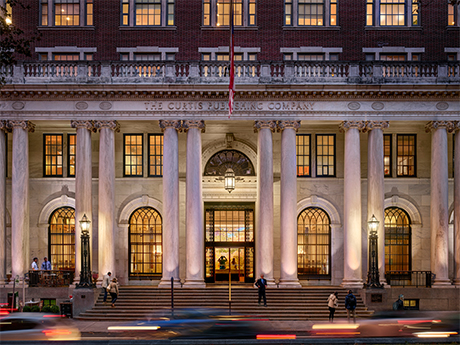By Michael Brookshier, vice president of development, Keystone
The COVID-19 pandemic sent renters flocking to spacious apartments in the suburbs. Now, in this post-pandemic world, just as companies revert to in-office work and homeownership becomes increasingly unattainable, renters are moving back to cities and seeking an urban lifestyle.
This re-acceleration to urban centers drives another trend in commercial real estate: converting outdated and vacant office buildings into stylish, amenity-filled residential buildings. To keep up, developers must strategically identify the right building, location and amenities in order to meet renters’ demands.

Philadelphia is a perfect example of an 18- to 24-hour city in which a large residential population in the central business district drives foot traffic outside of regular office hours. The Center City area also boasts an attractive downtown landscape of diverse uses such as office, residential, retail, award-winning restaurants and nightlife.
Find the Right Building
The ideal candidate for a successful office-to-residential conversion in an urban setting is often an office building constructed before World War II. These types of properties feature intricate designs, high-level finishes, ample natural light, outstanding views and beautiful and inviting lobbies that lend historical architectural details that are conducive and appealing to residential living.
Along with these considerations, developers must seek projects in walkable city centers near public transit, dining, retail and entertainment destinations. Apartments in these areas draw the most interest from prospective renters seeking vibrant, 24/7 living experiences.
At The Curtis, a historic redevelopment facility in Center City, Keystone leveraged strong site fundamentals like location and architectural details to successfully convert office space into 86 luxury residential units as well as life sciences and retail space.
The geometry and configuration of floor plates are also prominent factors to consider when transitioning office layouts into living spaces. These characteristics are not always present in office buildings constructed after World War II. In addition to their oversized floor plates, these buildings usually have less ornamental design features and inoperable windows.
However, some post-war buildings are candidates for conversion, as long as the floors are the right size, the distance from exterior glass to the interior core isn’t too deep and the column spacing works for residential use. Conversion of post-war office buildings can even work in suburban locations if the structures are well-located in neighborhoods with shopping, restaurants and transit nearby.
In addition to a building’s physical characteristics, other challenges to residential conversion may also be present. Underutilized offices are often located in areas zoned for office usage only. Where multifamily residential is not allowed, a change in zoning is required.
Fortunately, local officials generally recognize that demand for office space has changed and have been cooperative in making regulatory changes to help solve the problem. Currently, rising construction costs and high interest rates are proving to be challenging barriers to new development. In recognition of this, some local governments — and even the federal government — have initiated programs that offer financial incentives for conversion projects, including low-interest loans.
Tailor to Renters’ Wants, Needs
There was strong demand for apartments even before the pandemic, and with today’s high interest rates making homeownership less attainable, demand is expected to remain strong for the foreseeable future. In a competitive leasing environment, developers must ensure that their residential conversions meet tenant demands and provide quality living places.
Offerings that were once considered luxuries — pet spas, golf simulators, coworking lounges — are now standard features. To attract, retain and exceed potential residents’ expectations, developers must now incorporate next-level amenities into their properties. For instance, the typical golf simulator has evolved into a multi-sport simulator, and coworking spaces have been expanded to include conference rooms of various sizes for in-person meetings and Zoom rooms for remote calls.
Finding ways to capitalize on current trends will help developers best position themselves for conversion projects. The hybrid work model, for example, has made the industry hone in on creating a mixed-use, live-work-play environment where residents can have a 24-hour day at their fingertips.
In addition, hosting guests and spending time outside is a priority for residents in the post-pandemic world. Developers should adhere to this trend by continuing to create flexible, yet activity-filled outdoor spaces with offerings like dog parks, climbing walls, pickleball courts, putting greens and pools with outdoor seating and grilling stations. Indoor amenities like game rooms, movie theaters and communal cooking and dining areas have also been well-received. Areas like these are attractive to residents who like to entertain larger groups than they can accommodate in their apartments.
With trends and preferences shifting so rapidly, developers need to maintain dialogue with existing property management teams and residents about their utilization of amenities. It’s also important for developers to closely track competing products and connect with outside management to identify new and creative approaches to amenity design. The most future-proof strategy focuses on flexibility — designing generalized spaces that can quickly adapt to the next trend.
Local developers like Keystone are shifting their overall strategies to include the transformation of outdated and under-used offices into stylish rentals with an attractive slates of amenities. By proactively targeting promising buildings for office-to-residential conversion, developers can meet demand from younger demographics who desire walkable, mixed-use, amenity-rich living in vibrant, 24/7 neighborhoods.
— Headquartered in Philadelphia, Keystone is a vertically integrated investment and development firm with a portfolio of roughly 10 million office and mixed-use properties along the East Coast.


